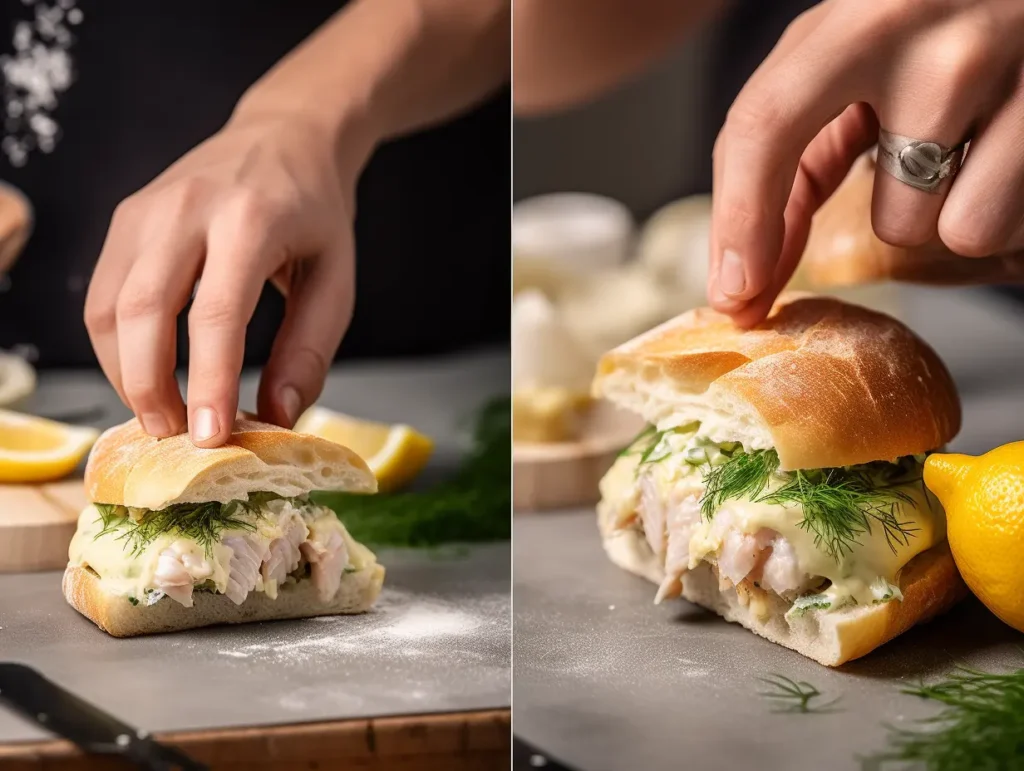If you’re craving a taste of authentic German street food, look no further than the beloved Matjesbrötchen. This humble yet flavorful sandwich is a staple in coastal Germany, known for its unique combination of pickled herring, fresh onions, and soft bread rolls. In this comprehensive guide, we’ll dive into everything you need to know about the Matjesbrötchen — from its history and cultural significance to step-by-step instructions for making it at home.
Table of Contents
What Is a Matjesbrötchen Recipe? A German Classic Explained
A Matjesbrötchen is more than just a sandwich — it’s a symbol of North German culinary tradition. The term Matjesrefers to young, lightly salted herring, which is the star ingredient of this classic dish. Combined with a soft bread roll (Brötchen), thinly sliced onions, and sometimes a dash of fresh herbs, this sandwich is both simple and packed with bold flavors.
What Does ‘Matjes’ Mean?
The word Matjes comes from the Dutch word maatjesharing, which means “virgin herring.” These young herrings are caught before they mature, ensuring a delicate, mild flavor. Unlike other pickled fish, Matjes herring is cured with a light salt solution, making it less salty and more buttery in texture.
The Cultural Significance of Matjesbrötchen in Germany
In Germany, particularly in coastal areas like Hamburg and Bremen, Matjesbrötchen is a beloved street food. It’s often enjoyed at fish markets, festivals, and seaside towns. The sandwich embodies the maritime culture of the region, where fishing has been a way of life for centuries.
Matjesbrötchen is more than a snack — it’s a tradition. For locals, grabbing a fresh Matjesbrötchen from a vendor is a must-do when visiting harbors or fish markets. It’s quick, hearty, and a perfect representation of coastal German cuisine.
Regional Variations of the Recipe
While the classic Matjesbrötchen recipe includes bread rolls, herring, and onions, there are numerous variations. In some regions, you’ll find the sandwich with added toppings like pickles, fresh herbs, or creamy sauces. In Schleswig-Holstein, for example, Matjes is often paired with apple slices or mustard sauce to balance the richness of the fish.
Each variation has its charm, but the core components remain the same: fresh herring and a hearty roll. Whether you prefer yours with a traditional twist or a modern flair, one thing’s certain — the Matjesbrötchen is a must-try for anyone exploring German cuisine.
Ingredients for a Perfect Matjesbrötchen Recipe

Crafting an authentic Matjesbrötchen Recipe starts with selecting the right ingredients. The key to success lies in using fresh, high-quality components that enhance the flavor of the herring while keeping the dish light and refreshing. Now, we are going to take a closer look at the essentials you’ll need.
Must-Have Ingredients for an Authentic Matjesbrötchen Recipe
At the heart of any great Matjesbrötchen is the Matjes herring. These young, pickled herrings provide the signature flavor of the sandwich — mild, salty, and slightly tangy. You’ll also need a few more simple ingredients to bring it all together:
- Matjes herring fillets (fresh or jarred)
- Soft bread rolls (Brötchen) — ideally crusty on the outside and fluffy on the inside
- Onions — thinly sliced for a sharp bite
- Butter or mayonnaise — to add richness
- Lemon wedges — for a zesty kick
- Fresh herbs — like dill or parsley, to enhance the flavor
Each ingredient plays a role in balancing the flavors. The bread roll acts as a sturdy base, the onions provide crunch, and the lemon adds brightness. Don’t forget the butter or mayonnaise to prevent the sandwich from feeling too dry.et the butter or mayonnaise to prevent the sandwich from feeling too dry.
Optional Toppings to Customize Your Matjesbrötchen Recipe
Not all herring is created equal! When shopping for Matjes herring, look for fillets that are plump, tender, and lightly salted. Fresh Matjes are often found at fish markets, but jarred options are also widely available in grocery stores. If you go for jarred herring, make sure it’s packed in a mild brine, not vinegar, to maintain that smooth texture.
Optional Toppings to Enhance the Flavor
While the traditional Matjesbrötchen Recipe is relatively simple, you can add toppings to suit your taste. Popular options include:
- Pickled cucumbers for a tangy crunch
- Sliced apples for a touch of sweetness
- Mustard sauce for a spicy kick
- Fresh lettuce for added texture
Feel free to get creative with your toppings, but remember that the Matjes herring should always be the star of the show.
Step-by-Step Guide to Make a Matjesbrötchen Recipe at Home

Now that you’ve gathered your ingredients, it’s time to bring this Matjesbrötchen Recipe to life. Follow these simple steps to prepare a delicious, traditional German sandwich at home.
How to Prepare Matjes Herring for Your Recipe
Start by rinsing the Matjes herring fillets under cold water to remove any excess salt. Pat them dry with a paper towel. If your fillets have skin, gently remove them before assembling the sandwich. Once cleaned, set the fillets aside while you prepare the other ingredients.
For a more intense flavor, you can marinate the herring in a mixture of lemon juice, dill, and a touch of olive oil. This step isn’t mandatory but adds a nice twist to the classic recipe.
How to Choose the Perfect Bread Roll
The bread roll, or Brötchen, is just as crucial as the herring itself. A good roll should be crusty on the outside and soft inside, creating a perfect balance between chewy and tender. Traditional German bakeries often carry Brötchen, but if you’re making this dish outside Germany, you can substitute it with a French baguette or ciabatta roll.
Before assembly, lightly toast the bread to add extra crunch and prevent it from becoming soggy when paired with the herring.
Assembly of the Matjesbrötchen
Here’s how to assemble your Matjesbrötchen step by step:
- Cut the bread roll in half and spread a thin layer of butter or mayonnaise on both sides.
- Place the herring fillets on the bottom half of the roll.
- Add thinly sliced onions on top of the fish for a sharp, crunchy bite.
- Squeeze a little lemon juice over the onions to enhance the flavors.
- Sprinkle fresh herbs like dill or parsley to finish.
Place the top half of the rollover the fillings, gently press, and you’re ready to serve!
Easy Assembly Tips for a Delicious Matjesbrötchen Recipe
Presentation matters! Serve your Matjesbrötchen on a rustic wooden board with a wedge of lemon on the side. For an authentic touch, pair it with a cold German beer or a refreshing apple cider.
Want to impress your guests? Add a small side of pickles, potato salad, or coleslaw for a complete meal. And don’t forget — the sandwich is best enjoyed fresh, so serve it right after assembly.
Regional Variations of the Matjesbrötchen Recipe
One of the best things about the Matjesbrötchen Recipe is its versatility. While the classic version is simple and delicious, there are countless ways to customize it based on your personal taste preferences or regional influences.
Classic Matjesbrötchen Recipe vs. Modern Twists
The traditional Matjesbrötchen features just a few key ingredients — fresh Matjes herring, onions, and bread. However, modern variations add exciting twists to the original recipe. You’ll find options with creamy sauces, spicy mustard, or even sliced apples to balance the salty herring. Some recipes swap the classic bread roll for rye bread or baguette for a more rustic feel.
Looking for more German-inspired dishes? Check out our Crockpot Beef Tips and Noodles recipe for another hearty meal idea.
Unique Takes on the Matjesbrötchen Recipe from Different Regions
Different regions in Germany put their spin on the Matjesbrötchen Recipe. In Schleswig-Holstein, it’s common to pair Matjes with apple slices or horseradish for a tangy kick. Meanwhile, in Hamburg, you’ll find versions with creamy remoulade or mustard sauce.
Each variation keeps the core ingredients but adds local flair to create a unique taste experience.
Health Benefits of Eating a Matjesbrötchen Recipe
While the Matjesbrötchen Recipe is undeniably tasty, it’s also packed with nutritional benefits. From the omega-3 fatty acids found in herring to the fiber in whole-grain bread, this sandwich can be both delicious and healthy.
Nutritional Value of Matjes Herring
Matjes herring is rich in omega-3 fatty acids, which promote heart health, reduce inflammation, and improve brain function. The fish is also a great source of protein, vitamin D, and B vitamins. Adding fresh onions provides antioxidants, while whole-grain bread offers fiber to keep you feeling full longer.
How to Make a Healthier Matjesbrötchen
To make a healthier version of the Matjesbrötchen Recipe, opt for whole-grain bread instead of white rolls. You can also cut back on butter or mayonnaise by using a lighter spread, such as Greek yogurt mixed with herbs. Adding fresh vegetables like lettuce, cucumber, or radish can further boost the sandwich’s nutritional value.
Common Allergens to Watch Out For
Since the Matjesbrötchen contains fish, it’s important to note that it may trigger allergies in some people. Additionally, those with gluten intolerance should choose gluten-free bread options to enjoy this classic dish safely.
The History of the Matjesbrötchen Recipe in German Cuisine
The Matjesbrötchen Recipe isn’t just a sandwich; it’s a story rooted in German coastal traditions. For centuries, herring fishing has been a way of life for communities along the North Sea, and this beloved dish is a testament to that heritage.
The Origin of Matjes Herring
The history of Matjes herring dates back to the 14th century when Dutch fishermen perfected a method of curing young herring. This process, known as brining, made it possible to preserve the fish for more extended periods. The technique quickly spread to neighboring regions, including northern Germany.
In German towns like Hamburg and Bremen, Matjesbrötchen became a popular street food. Fishermen would sell freshly caught and brined herring directly at harbors, serving it in bread rolls to hungry travelers and locals.
Matjesbrötchen as a Street Food Staple
Today, Matjesbrötchen is a common sight at German fish markets, particularly during the annual Matjesfest in Glückstadt. The festival celebrates the arrival of fresh Matjes and highlights various regional takes on the dish. Whether enjoyed at a seaside stall or a bustling street market, the Matjesbrötchen Recipe continues to be a symbol of German maritime culture.jesbrötchen Recipe continues to be a symbol of German maritime culture.
FAQs About Matjesbrötchen
Curious about the Matjesbrötchen Recipe? Here are some frequently asked questions to help you better understand this iconic dish.
What Does a Matjesbrötchen Taste Like?
The Matjesbrötchen offers a unique blend of flavors. The Matjes herring is mild yet salty, with a buttery texture that melts in your mouth. Paired with the sharpness of onions and the crunch of fresh bread, it creates a balanced, satisfying bite. The lemon juice adds a refreshing tang that brightens the dish.
Can I Use Different Types of Fish?
While the classic recipe calls for Matjes herring, you can experiment with other types of fish. Smoked salmon, mackerel, or even pickled sardines can be used as alternatives. However, keep in mind that the flavor profile will change depending on the fish you choose.
How Long Does a Matjesbrötchen Stay Fresh?
A freshly made Matjesbrötchen is best enjoyed immediately to preserve the textures and flavors. If you need to store it, wrap the sandwich tightly in foil and refrigerate it. However, it’s recommended to consume it within 24 hours to avoid sogginess.
Can I Make a Vegan Version of Matjesbrötchen?
Absolutely! For a plant-based version, you can replace the herring with marinated eggplant or pickled tofu. Season the substitutes with seaweed to mimic the ocean flavor of Matjes. Pair it with the same traditional toppings — onions, herbs, and lemon — for an equally satisfying bite.
Looking for more inspiration? Check out our Hillbilly Fish Fry Seasoning Recipe or Chicken Tempura Roll for ideas on seasoning fish dishes to perfection.
Print
Matjesbrötchen Recipe: The Ultimate Guide to Crafting This German Classic
- Total Time: 10 minutes
- Yield: 2 Matjesbrötchen (serves 2) 1x
Description
A classic German fish sandwich featuring tender, mildly sweet Matjes herring, crisp onions, pickles, and fresh lettuce, all tucked into a soft, crusty roll. Simple, refreshing, and full of coastal flavor!
Ingredients
- 2 fresh Brötchen (crusty bread rolls)
- 4 Matjes herring fillets
- 1 small red onion, thinly sliced
- 1–2 pickles, thinly sliced
- A few leaves of crisp lettuce
- 2 tbsp remoulade or sour cream
- Freshly ground black pepper (optional)
- Lemon wedges (for serving)
Instructions
- Prepare the Rolls: Slice the Brötchen in half horizontally without cutting all the way through. Lightly toast if desired.
- Add the Spread: Spread a layer of remoulade or sour cream on the bottom half of each roll.
- Layer the Ingredients: Place a few lettuce leaves on the spread, then add 1-2 Matjes fillets per roll.
- Add Crunch: Top with thinly sliced onions and pickles.
- Season: Add a pinch of freshly ground black pepper if desired.
- Serve: Close the rolls gently, serve with lemon wedges on the side, and enjoy immediately!
Notes
- Matjes Quality: Use fresh, high-quality Matjes herring for the best flavor. Look for fillets that are tender and mildly salty.
- Bread Choice: Traditional Brötchen works best, but any crusty roll with a soft interior will do.
- Flavor Boost: Add a squeeze of fresh lemon juice for extra brightness.
- Extra Toppings: For variation, try adding sliced apples, radishes, or a sprinkle of fresh dill.
- Serving Tip: Best enjoyed fresh, as the bread can become soggy if stored for too long.
- Prep Time: 10 minutes
- Cook Time: None (optional to toast the rolls)
- Category: Snack, Sandwich
- Method: Assembly
- Cuisine: German (Northern coastal regions)

